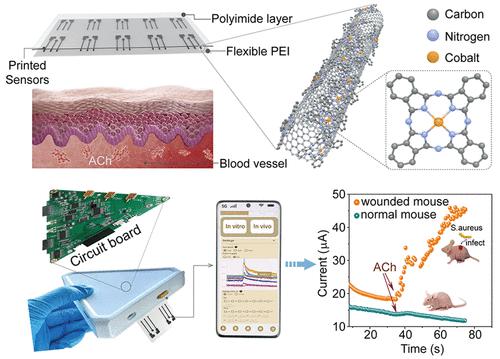Our official English website, www.x-mol.net, welcomes your
feedback! (Note: you will need to create a separate account there.)
Integrated Biochip–Electronic System with Single-Atom Nanozyme for in Vivo Analysis of Nitric Oxide
ACS Nano ( IF 15.8 ) Pub Date : 2023-04-21 , DOI: 10.1021/acsnano.3c00935 Fang Xin Hu , Guangxuan Hu , Dong Ping Wang 1 , Xinxuan Duan 2 , Linrun Feng 3 , Bo Chen , Yuhang Liu , Jie Ding 4 , Chunxian Guo , Hong Bin Yang
ACS Nano ( IF 15.8 ) Pub Date : 2023-04-21 , DOI: 10.1021/acsnano.3c00935 Fang Xin Hu , Guangxuan Hu , Dong Ping Wang 1 , Xinxuan Duan 2 , Linrun Feng 3 , Bo Chen , Yuhang Liu , Jie Ding 4 , Chunxian Guo , Hong Bin Yang
Affiliation

|
Nitric oxide (NO) exhibits a crucial role in various versatile and distinct physiological functions. Hence, its real-time sensing is highly important. Herein, we developed an integrated nanoelectronic system comprising a cobalt single-atom nanozyme (Co-SAE) chip array sensor and an electronic signal processing module (INDCo-SAE) for both in vitro and in vivo multichannel qualifying of NO in normal and tumor-bearing mice. The high atomic utilization and catalytic activity of Co-SAE endowed an ultrawide linear range for NO varying from 36 to 4.1 × 105 nM with a low detection limit of 12 nM. Combining in situ attenuated total reflectance surface enhanced infrared spectroscopy (ATR-SEIRAS) measurements and density function calculation revealed the activating mechanism of Co-SAE toward NO. The NO adsorption on an active Co atom forms *NO, followed by the reaction between *NO and OH–, which could help design relevant nanozymes. Further, we investigated the NO-producing behaviors of various organs of both normal and tumor-bearing mice using the proposed device. We also evaluated the NO yield produced by the wounded mouse using the designed device and found it to be approximately 15 times that of the normal mouse. This study bridges the technical gap between a biosensor and an integrated system for molecular analysis in vitro and in vivo. The as-fabricated integrated wireless nanoelectronic system with multiple test channels significantly improved the detection efficiency, which can be widely used in designing other portable sensing devices with multiplexed analysis capability.
中文翻译:

用于一氧化氮体内分析的单原子纳米酶集成生物芯片电子系统
一氧化氮 (NO) 在各种多样和独特的生理功能中发挥着至关重要的作用。因此,其实时传感非常重要。在此,我们开发了一种集成纳米电子系统,包括钴单原子纳米酶 (Co-SAE) 芯片阵列传感器和电子信号处理模块 (IND Co-SAE),用于正常和肿瘤中 NO 的体外和体内多通道鉴定-轴承小鼠。Co-SAE 的高原子利用率和催化活性赋予了 NO 的超宽线性范围,范围从 36 到 4.1 × 10 5 nM,检测限低至 12 nM。就地结合衰减全反射表面增强红外光谱 (ATR-SEIRAS) 测量和密度函数计算揭示了 Co-SAE 对 NO 的激活机制。活性钴原子上的 NO 吸附形成 *NO,随后 *NO 与 OH -发生反应,这有助于设计相关的纳米酶。此外,我们使用所提出的装置研究了正常和荷瘤小鼠的各种器官的 NO 产生行为。我们还使用设计的装置评估了受伤小鼠产生的 NO 产量,发现它大约是正常小鼠的 15 倍。这项研究弥合了生物传感器与体外和体内分子分析集成系统之间的技术差距. 制造的具有多个测试通道的集成无线纳米电子系统显着提高了检测效率,可广泛用于设计具有多路复用分析能力的其他便携式传感设备。
更新日期:2023-04-21
中文翻译:

用于一氧化氮体内分析的单原子纳米酶集成生物芯片电子系统
一氧化氮 (NO) 在各种多样和独特的生理功能中发挥着至关重要的作用。因此,其实时传感非常重要。在此,我们开发了一种集成纳米电子系统,包括钴单原子纳米酶 (Co-SAE) 芯片阵列传感器和电子信号处理模块 (IND Co-SAE),用于正常和肿瘤中 NO 的体外和体内多通道鉴定-轴承小鼠。Co-SAE 的高原子利用率和催化活性赋予了 NO 的超宽线性范围,范围从 36 到 4.1 × 10 5 nM,检测限低至 12 nM。就地结合衰减全反射表面增强红外光谱 (ATR-SEIRAS) 测量和密度函数计算揭示了 Co-SAE 对 NO 的激活机制。活性钴原子上的 NO 吸附形成 *NO,随后 *NO 与 OH -发生反应,这有助于设计相关的纳米酶。此外,我们使用所提出的装置研究了正常和荷瘤小鼠的各种器官的 NO 产生行为。我们还使用设计的装置评估了受伤小鼠产生的 NO 产量,发现它大约是正常小鼠的 15 倍。这项研究弥合了生物传感器与体外和体内分子分析集成系统之间的技术差距. 制造的具有多个测试通道的集成无线纳米电子系统显着提高了检测效率,可广泛用于设计具有多路复用分析能力的其他便携式传感设备。















































 京公网安备 11010802027423号
京公网安备 11010802027423号